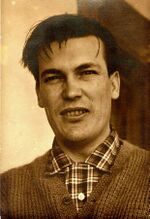Biography:Gregorio Baro
Gregorio Baro | |
|---|---|
 | |
| Born | June 19, 1928 Santiago Temple, Córdoba Province, Argentina |
| Died | May 28, 2012 (aged 83) Buenos Aires, Argentina |
| Nationality | Argentine |
| Alma mater | Universidad de Buenos Aires |
| Known for | Discovery of new radioisotopes of ruthenium, rhodium, rhenium, tungsten, and osmium, and the development of an MRI contrast agent |
| Scientific career | |
| Fields | Radiochemistry, nuclear chemistry |
| Institutions | National Atomic Energy Commission |
| Doctoral advisor | Adrian Aten, Instituut voor Kernphysisch Onderzoek |
| Other academic advisors | Walter Seelmann-Eggebert, Karlsruhe Institute of Technology |
Gregorio Baró (June 19, 1928 - May 28, 2012) was an Argentine scientist. He was born in Santiago Temple, Córdoba and died in Buenos Aires.
Biography
The son of Spanish immigrants from the Province of León, more precisely from Cabreros del Río, Baró married the writer María Dhialma Tiberti. He completed his Associate of Science in Chemistry degree at the Otto Krause Technical School in Buenos Aires, in 1945. Afterward, he pursued his studies at Universidad de Buenos Aires from which he obtained a Bachelor of Science, followed by a PhD in Chemistry in 1961 at the Instituut voor Kernphysisch Onderzoek, in Amsterdam.[1] In 1968, he conducted research on the production of radioisotopes in Bombay, India, organized by the International Atomic Energy Agency.[2]
Baró was additionally a professor at several universities, such as Universidad de Buenos Aires, Universidad Nacional de La Plata, Universidad Nacional de Cuyo, Universidad Nacional de Rosario, and Universidad Nacional del Litoral.[citation needed] He was named Emeritus Researcher of the National Atomic Energy Commission in 2010, following 40 years of institutional work and reaching the rank of Director.[3] He was also awararded a Doctor honoris causa in Radiochemistry from Higher University of San Andres, Bolivia, notably for his work in discovering new isotopes of ruthenium, rhodium, rhenium, tungsten, and osmium,[4][5] and for the development of a contrast agent for Magnetic Resonance Imaging during retirement.
He was the Argentinian representative of the International Union of Pure and Applied Chemistry (IUPAC) for several years. In addition, he served as consultant for the Comisión de Energía Atómica de Bolivia, the Comisión Chilena de Energía Nuclear, the Instituto de Asuntos Nucleares de Colombia, the International Atomic Energy Agency in Asunción, Paraguay, and the Centro Atómico del Perú, and the government of Uruguay.
References
- ↑ Baró, Gregorio Bonifacio. "Estado químico del arsénico formado por transformaciones nucleares en compuestos inorgánicos de germanio, selenio, bromo y arsénico". bibliotecadigital.. https://bibliotecadigital.exactas.uba.ar/download/tesis/tesis_n1096_Baro.pdf.
- ↑ Radicella, R. (1992), Walter Seelmann-Eggebert: el fundador de la radioquímica argentina. Ciencia e Investigación: Buenos Aires.
- ↑ AATN (2010). Herederos de la Antigua Alquimia, BN&T, v, 14-15.
- ↑ Barbero, A.(1967) Revista. Sociedad Científica del Paraguay.
- ↑ FLEGENHEIMER, J. (2014). The mystery of the disappearing isotope. Revista Virtual de Química, V. XX. Available at http://www.uff.br/RVQ/index.php/rvq/article/viewFile/660/450
- Ciencia y Educacion
- CNEA
- La Prensa
- Martinez Ruiz, E. & de Pazzis Pi Corrales, M. (2010). Protección y seguridad en los sitios reales desde la ilustración al liberalismo. Universidad de Alicante: San Vicente del Raspeig.
- University of California. (1969). Who's who in Atoms, Vallency Press: London, 132 134.
External links
- Asociación Argentina de Tecnología Nuclear
- Comisión Nacional de Energía Atómica
- Consejo Nacional de Investigaciones Científicas y Técnicas
- Universidad de Buenos Aires
- Universidad Mayor San Andrés
 |

